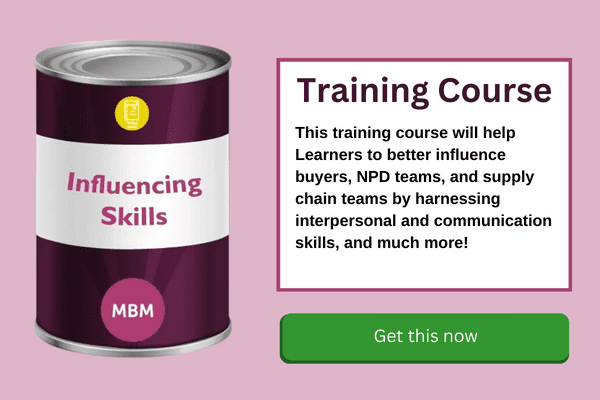Whilst Getting Our Own Way Can Sound Childish the Facts are That We All Would Like to Feel That in a Non-Manipulative Way, We Positively Persuade, Cajole, and Influence People to Do What We Need Them to Do.
Influencing is an important soft skill because, ‘You get more done and you advance the projects you care about and are responsible for, which means you’re more likely to be noticed, get promoted, and receive raises.’, says Dorie Clark, author of the Entrepreneurial You, speaking with Harvard Business Review.
Let’s take a look at the research of this influencing skills model, what it means, and most importantly, how we can use it to get our own way.

Going Back to the Roots
In 1980 three people researched and had published in the Journal of Applied Psychology, their findings of influencing people. They were Stuart Schmidt, Ian Wilkinson and David Kipnis. Their research was groundbreaking and hence why it is still referred to, today. Later, their research was built upon further, but let’s start with what they discovered.
Their research paper of 12 pages was titled, ‘Intraorganizational influence tactics: Explorations in getting one’s way’. It concluded that there were 8 influencing tactics – things that people did – to get their own way. They were:
- Ingratiation
- Rationality
- Assertiveness
- Sanction
- Exchange
- Upward Appeal
- Blocking
- Coalitions
Building Upon their Work

Then, in 2012 Chris Musselwhite and Tammie Plouffe published an article in the Harvard Business Review, building on the 8 dimensions and arriving at 5. Those five were:
- Rationalising
- Asserting
- Negotiating
- Inspiring
- Bridging
It is these influencing styles that have become the most widely used and known as the influencing skills model.
The Modern-Day Influencing Skills Model
The influencing skills model most used today is based on the HBR article mentioned above. It is well accepted as the way to influence and yet many have heard of it, some can explain it, but few can do it. Let’s see if we can change that and achieve real behavioural change together.
We’ll take each of these 5 influencing techniques in turn and understand what they are, how they influence, and how we can use them.

Sticky Learning ® is 7 times more effective than 1-day training courses. Plus, you will get a Chain of Evidence proving your Return on Investment. Discover soft skills training that changes behaviours long term.

What is the Influencing Skills Model?
Rationalising
This influencing style is all about using logic, reason, and facts.
Asserting
Using your authority, confidence, and rules, is what this influencing style is all about.
Negotiating
Giving something to get something, seeking compromise, and exchanges – The negotiating influencing style.
Inspiring
Communicating an exciting way forward. Maybe using a story or a metaphor.
Bridging
Reach across to people by using your relationship, building a partnership, or simple reciprocity.
Learning this Influencing Skills Model
I’ve heard of the influencing skills model before, yet never managed to retain it, or use it in my everyday working life. I find the push-pull model a simpler and more effective influencing technique. Maybe we can jump that hurdle and include this influencing skills model in our armoury of everyday useful influencing techniques. As a soft skill student, advocate and trainer of +20 years, influencing is one of the soft skills that without it, you are forever going to hit against your glass ceiling. Become a great influencer if you want to get ahead. Don’t get left behind.

To begin, the part that has amazed me is that no one has turned this into a mnemonic. Mnemonics are simple ways to remember and retain things. You were taught how to remember the points of a compass with ‘Naughty Elephant Squirted Water’ – N E S W. Or how to remember the colours of the rainbow with a song about ‘Richard of York Gave Battle in Vain’. Mnemonics are a useful start because first, we need to remember them. Then we need to use it.
These 5 influencing techniques:
- Rationalising
- Asserting
- Negotiating
- Inspiring
- Bridging
Become these 5:
- Bridging
- Rationalising
- Asserting
- Inspiring
- Negotiating
Let’s influence people using our B.R.A.I.N. Now we have our mnemonic we need some examples of how others use it. This is the pragmatist learning style and is essentially asking, ‘Ok, I get that, but how do I actually use it in the real world?’. Next, we’ll answer that together…
Examples of this Influencing Skills Model – B.R.A.I.N.
How to Use Bridging
The objective of the bridging technique is to make a, well, bridge from you to them. A connection. This technique is all about involving, listening and disclosing. It’s all about them.

Here are 3 ways you can use the Bridging influencing technique:
- Share with the other person a mistake you have made. Vulnerabilities show humility and this helps others to like us because we are the opposite of arrogant and able to show that we get things wrong and that this is ok. ‘I made a mistake on this project. I should have xyz, rather than abc’.
- Show them that you are listening. Really listening. Do this by summarising what they are saying, or paraphrasing, or just saying that, ‘I hear you are finding the project xyz tough because…’.
- Ask their opinion and genuinely take it into account.
Imagine a person that really listens and connects with you. Maybe an Uncle.
How to Use Rationalising
The rationalising technique’s objective is to share information. It’s all about the facts, logic and reason.
Use the Rationalising influencing technique in these 3 ways:
- ‘My analysis shows that the best option is…’. This would be a rationalising sentence you would use.
- ‘Our team of experts concluded that the best way forward was to…’.
- Invite them to walk through the data, ask questions, and see if they arrive at the same conclusion.
Imagine a professor sharing the findings of their research.
How to Use Asserting
Asserting is the third of the 5 influencing techniques of the B.R.A.I.N. mnemonic. Compliance is really the name of the game here.
Compliance is the aim of the Asserting technique and here are 3 forms:
- Sharing your expectation with the other person.
- ‘The standard we really need to achieve is as per the ABC manual’.
- ‘I really need this done but Friday, please’.
If you can see in your mind’s eye a teacher, this would be the person to imagine.
How to Use Inspiring
Inspiring is all about ‘visioning’. Creating a picture of what the wonderful end game looks like and exciting them to come aboard.

Visioning in 3 ways:
- ‘Together we can build something that is groundbreaking’.
- Highlighting a common value is important, Like, ‘We both believe in doing the very best for the client and this way we can’.
- Sharing how excited you are about the initiative might be enough to get them excited and to come on board.
Richard Branson sharing his vision for Virgin. This is who I imagine.
How to Use Negotiating
Negotiation is an art. Most people haggle and this is not negotiating. This is all bout trading. Compromising to achieve the win:win together.
Three examples of negotiating are:
- The simplest and most effective negotiating tool is, ‘If you…, then I…’. A tool that enables us to construct a sentence asking for what we want and then giving something in return.
- Accepting that you will not get all that you want without giving up something, so be prepared to concede something.
- Asking the other party what they want can help you to know what you need to give in order to get what you want.
Imagine a Trade Union negotiator. Tough, fair, and demanding.
Using this Influencing Skills Model – B.R.A.I.N.
So, where does that leave us?

We have a mnemonic we can remember – Use your B.R.A.I.N. when influencing. The next step is to recognise what we do naturally. I have taken the 5 and ranked them in order of which ones I use most to least:
- Inspiring – Most
- Rationalising
- Negotiating
- Asserting
- Bridging – Least
In order for me to change my behaviour I need to start small and knowing that Bridging is my weakest influencing technique of the 5, I need to remind myself of the 3 examples and reduce these to something I can now remember and use:
Version 1:
- Share with the other person a mistake you have made. Vulnerabilities show humility and this helps others to like us because we are the opposite of arrogant and able to show that we get things wrong and that this is ok. ‘I made a mistake on this project. I should have xyz, rather than abc’.
- Show them that you are listening. Really listening. Do this by summarising what they are saying, or paraphrasing, or just saying that, ‘I hear you are finding the project xyz tough because…’.
- Ask their opinion and genuinely take it into account.
Becomes Version 2:
- Share a mistake.
- Summarise when I listen.
- Ask their opinion.
This Then Becomes Version 3:
- Mistake.
- Summarise.
- Opinion.
Next time I want to influence someone B.R.A.I.N. will come to mind and then Mistake, Summarise and Opinion. For me, this becomes BRAIN-MOS. If I can make one small behavioural change by using this technique I will have improved my ability to influence significantly because I will have added one more tool to my influencing toolkit.
If you want to improve your negotiation skills take one small step first – rank the 5 techniques most to least, identify the piece you wish to change about your least influencing style, and then you will start to influence significantly better.
A Final Word of Help with this Influencing Skills Model
We influence how we like to be influenced. So, if we are a left-brain thinker, the rational technique will appeal to us because people like people like themselves. Your default is not everyone’s default. Adding a polar opposite influencing technique to your tool bag could really help you to influence the right-brain thinkers. The opposite of rational is probably inspiring.
Using this technique to influence you the reader. Testing what I have learnt by copying part from the article above:
- Bridging
- ‘I’ve heard of the influencing skills model before, yet never managed to retain it’ –
- Did I make a bridge to you through my humility?
- ‘I’ve heard of the influencing skills model before, yet never managed to retain it’ –
- Rationalising
- ‘Influencing is an important soft skill because, ‘You get more done and you advance the projects you care about and are responsible for, which means you’re more likely to be noticed, get promoted, and receive raises.’, says Dorie Clark, author of the Entrepreneurial You, speaking with Harvard Business Review.
- Did I reason with you?
- ‘Influencing is an important soft skill because, ‘You get more done and you advance the projects you care about and are responsible for, which means you’re more likely to be noticed, get promoted, and receive raises.’, says Dorie Clark, author of the Entrepreneurial You, speaking with Harvard Business Review.
- Asserting
- ‘As a soft skill student, advocate and trainer of +20 years, influencing is one of the soft skills that without it, you are forever going to hit against your glass ceiling.’
- Did I assert myself?
- Inspiring
- ‘Become a great influencer if you want to get ahead. Don’t get left behind’.
- Did I inspire you?
- ‘Become a great influencer if you want to get ahead. Don’t get left behind’.
- Negotiating
- ‘If you want to improve your negotiation skills take one small step first – rank the 5 techniques most to least, identify the piece you wish to change about your least influencing style, and then you will start to influence significantly better.’
- Did I negotiate a deal with you?
- ‘If you want to improve your negotiation skills take one small step first – rank the 5 techniques most to least, identify the piece you wish to change about your least influencing style, and then you will start to influence significantly better.’




